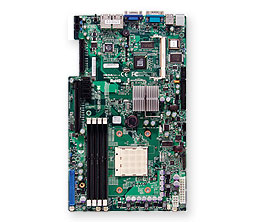Difference between revisions of "Tomato"
m (→/etc/exports) |
m (→VMWare) |
||
| Line 53: | Line 53: | ||
The VMWare datastore is located in /data0/vmware | The VMWare datastore is located in /data0/vmware | ||
| − | ==Guest VMs== | + | ===Guest VMs=== |
*[[corn]] - Bugzilla bug tracker | *[[corn]] - Bugzilla bug tracker | ||
| − | |||
= Disks and Raid Configuration = | = Disks and Raid Configuration = | ||
Revision as of 13:22, 17 June 2010
The hostname Tomato is currently being used for the rackmount server which was previously known as Einstein. If you're looking for information about the system formerly known as Tomato, it has been renamed Okra.
Currently tomato isn't used for anything critical, but it does serve as a secondary DNS server and VMWare host.
Hardware Information
- Motherboard: SuperMicro H8SMU
- nVidia MCP55-Pro chipset
- SAS Backplane: SAS825TQ
- Dual-Core AMD Opteron 1218 Processor
- 4 GB 333 MHz DDR Memory
- Marvell Technology Group Ltd. MV88SX6081 8-port SATA II PCI-X
- Two NVIDIA MCP55 Integrated Gigabit Ethernet Ports
- Matshita DVD-ROM
- ATI ES1000 Video
Network Configuration
Tomato has an ethernet cable connected to the switch for local (farm) connection, and uses a vlan configuration for the connection to the external (unh) network.
- IP address UNH: 132.177.88.52 (eth1)
- IP address Farm: 10.0.0.248 (eth0)
- IP address IPMI: 10.0.0.148
Software and Services
This section contains details about the services and software on Gourd and information about their configurations.
IPTables
Tomato uses the standard NPG iptables firewall. Gourd allows ssh, icmp, portmap and nfs connections.
Tomato serves two volumes over NFS. They are located at /data0 and /data1. They are accessible via automount in /net/tomato on our systems.
/etc/exports
/data0 @servers(rw,sync) @npg_clients(rw,sync) \
10.0.0.0/24(rw,sync)
/data1 @servers(rw,sync) @npg_clients(rw,sync) \
10.0.0.0/24(rw,sync)
VMWare
Tomato is running VMWare Server version 2.0.2. It acts as a secondary virtualization server. The VMWare management interface is accessible at https://tomato.unh.edu:8333/ or from localhost:8222 if you're logged in or port forwarding over SSH.
The VMWare datastore is located in /data0/vmware
Guest VMs
- corn - Bugzilla bug tracker
Disks and Raid Configuration
Due to issues with the HD controller card in Tomato we are only using the bottom four hard drive bays, which are connected directly to SATA port on the motherboard.
Disks and Raid configuration
| Drive Bay | Disk Size | Raid Type | Raid level |
|---|---|---|---|
| 1 | 750 GB | Software RAID | Raid 1 |
| 2 | 750 GB | Software RAID | Raid 1 |
| 3 | 400 GB | Software RAID | Raid 1 |
| 4 | 400 GB | Software RAID | Raid 1 |
Volume Set and Partition configuration
| Raid device | Volume set | Volume size | Mount Point |
|---|---|---|---|
| /dev/md0 | sdb1 & sdc1 | 50 GB | System (/) |
| /dev/md1 | sdb2 & sdc2 | 630 GB | /data0 |
| /dev/md2 | sda1 & sdd1 | 343 GB | /data1 |
Special Considerations for Einstein (Historical)
This information no longer applies and is here for historical reasons. We no longer use amavisd, and so these instructions are not useful.
Einstein is our mail server. That means it runs "amavisd" (a virus scanner) and "spamassasin" a spam filter. Both these codes have some issues with leaving junk around, slowly causing the "/" file system to fill up. When that happens, einstein stops functioning.
Some cleanup can be done as follows:
- stop amavisd and spamassasin:
service amavisd stop service spamassasin stop
- clean out some of their junk:
rm /var/amavis/.razor/razor-agent.log touch /var/amavis/.razor/razor-agent.log chown amavis:amavis /var/amavis/.razor/razor-agent.log chmod o-r /var/amavis/.razor/razor-agent.log rm -f /var/virusmails/* # (Sometimes there are so many, you have to delete in "chunks") rm -rf /tmp
- start up the mail stuff again.
service amavisd start service spamassasin start
There may be other areas that can be clean up, as in all the archived mail from "mailman"? But at least this list will let einstein function again.
Hot Swap Information
- Interesting thread to get sata-nv to hotswap: ([1])
- There are drivers available for the MB sata, we could try them: Super Micro MB H8SMU drivers, BUT these appear to be standard Nvidia sata_nv driver.
- SAS Backplane: SAS825TQ
- SAT2-MV8 8-port SATA controller. Uses the sata-mv module which is NOT HOTPLUG CAPABLE. (see http://linux-ata.org/driver-status.html#matrix). THE ONLY WAY TO "HOT PLUG" with this driver is to dismount ALL the drives, then "modprobe -r sata-mv" (make sure it is really gone: lsmod | grep sata) then do the swap, then "modeprobe sata-mv" again.
